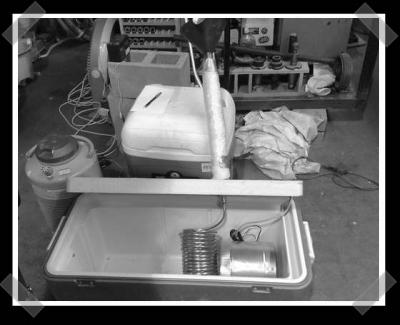
[3ricj] wrote up how to build your own low temperature test chamber to verify that electronics will function at the edge of the atmosphere/outerspace. He needs this for the edge of space project he’s working on. A large cooler serves as the test chamber. It’s cooled down to about 0c -42C with dry ice, then a supply of liquid nitrogen is fed into a copper heat exchanging coil to bring the chamber down to -70C.
9 thoughts on “Thermal Testing Electronics For Outer Space”
Leave a Reply
Please be kind and respectful to help make the comments section excellent. (Comment Policy)
















Quick correction to the above post: the LN2 cools it down to -70C or colder; with dry ice alone you can get down to -42C
Space, how about just for working in Canadian Prairie Winters!
@bonessk – That’s a good statement, as most consumer (or even “rugged”) electronics are rated at -40 to +80C, and that’s not good enough in winter in Canada (or any other country in the north :P). Winter in the territories is wicked.
I suppose the lack of air pressure is a further test that some components would need a test or a pressurized vessel for..
When I worked for the CSA we used a giant (as in ~50ft high) vacuum chamber. The device would be blasted with an array of halogen lights on one side, and chilled with liquid nitrogen on the other. You must realize that when facing the sun directly, there could be a 200 degree difference between front and back. This plays hell on electronics. Non uniform temperature distribution causes more malfunctions than any single extreme temperature – within reason :P
Mark is right, the main problem are huge temperature differences . You should also remember that in space there is heavy radiation, so you have to use special radhard IC or at last old ICs which have big transistors, not that easily destryed by single particle.
Looks like a super beer cooler !
You don’t need gigantic devices to get a small area (components) down to “space level” temps. The device I have at work (Space Level Components) is just an over-glorified refrigerator compressor. In order to hit the temps required for “space level”, you should really use nitrogen in the “air blast” instead of normal air, to avoid any issues with moisture freezing and damaging the device. Dry ice and LN2 is fun and all, but having a steady supply isn’t worth the effort. Re-purpose an old fridge compressor setup, add in some TECs (Peltier Devices) if its not enough, and have fun.
extreme cooling is not the only issue with electronics in space, over-HEATING is also a concern… without the effects of gravity (or in freefall, if you prefer), heated gas does not rise. Therefore, the heat from electronics isn’t naturally wafted away by the air. Without fan based cooling, electronics of even the most basic level gain an envelope of superheated air that can fry them…
Nice idea, it would be worth looking at the intercooler performance development.